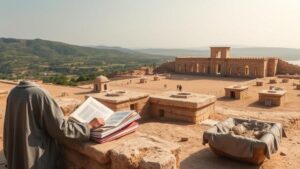Investigating the legends of a pre-Mongol city beneath the sands of the Gobi Desert.
Investigating the Legends of a Pre-Mongol City Beneath the Sands of the Gobi Desert
Deep within the vast expanse of the Gobi Desert, legends circulate about an ancient city, long forgotten and buried beneath shifting dunes. This place, often referred to as the Lost City, is believed to hold clues about pre-Mongol civilization in Central Asia. This article delves into the archaeological pursuits, legends, and historical significance surrounding this enigmatic urban center.
The Gobi Desert: A Harsh Yet Mysterious Landscape
The Gobi Desert, spanning parts of northern China and southern Mongolia, covers over 1.3 million square kilometers. Its environment is characterized by extreme temperatures, high winds, and sparse vegetation. Surprisingly, this harsh landscape was once a thriving corridor of trade, culture, and civilization, responsible for linking East and West along the ancient Silk Road.
Legends of the Lost City
The existence of a lost city beneath the sands has been debated by historians and archaeologists for decades. Inspiring tales among nomadic tribes, the legends speak of a vibrant metropolitan hub that was rich in culture and flourishing commerce. According to local folklore, this city was lost to a catastrophic event, often described as a sudden drought or sandstorm that buried it overnight.
- Historical Accounts: Ancient texts, including travelogues from explorers such as Marco Polo and more recent investigations, often reference this city, leading researchers to investigate its origins and fate.
- Local Myths: Tales shared among the Mongolian people speak of treasures and untouched relics waiting to be found, sparking occasional treasure hunts and expeditions.
Archaeological Investigations: Seeking the Lost City
In recent years, advancements in technology have reignited interest in the search for the lost city. Satellite imagery and aerial surveys have helped identify anomalies in the deserts landscape, suggesting structure remains buried beneath the dunes.
- Gobi Desert Expeditions: In the summer of 2019, a team of archaeologists employed ground-penetrating radar and drone technology to map the terrain. Their efforts led to the identification of certain features that resemble urban planning.
- Dating Artifacts: Artifacts discovered during excavations, such as pottery shards adorned with intricate designs, have been dated back to the 4th century AD, illustrating the areas historical depth.
Understanding Pre-Mongol Civilization
The legends of the lost city serve as a testament to the complex tapestry of cultures that once thrived in the region. pre-Mongol period, particularly during the time of the Xiongnu (circa 3rd century BC to 1st century AD), was notable for trade networks and cultural exchanges that laid the groundwork for later empires.
Developing a clearer understanding of pre-Mongol civilizations can reshape our historical narratives. For example, studies of nomadic tribes indicate that they played significant roles in trade and cultural diffusion, countering the perception that settled cities were the exclusive centers of civilization.
Challenges and Controversies in Archaeology
While investigations continue, challenges abound in unveiling the mystery of the lost city. Political and environmental factors complicate archaeological pursuits.
- Environmental Degradation: Climate change is altering the landscape, intensifying sandstorms that may further bury potential archaeological sites.
- Local Perspectives: Some local populations view the search for the city with skepticism, believing it disturbs sacred lands or undermines their cultural heritage.
Conclusion: The Call to Preserve History
The legends of a pre-Mongol city beneath the sands of the Gobi Desert captivate the imagination and invite continued exploration. As archaeological technologies evolve, they present new horizons for understanding this lost civilization. By fostering a collaborative approach that respects local views and addresses ecological concerns, historians and archaeologists can piece together the puzzle of the past while protecting the cultural heritage that remains hidden beneath the sands.
Ultimately, unraveling the mystery of the lost city not only enhances our historical understanding but also emphasizes the need for sustainable practices in archaeology and a deep respect for the narratives that local communities carry. As the quest for knowledge persists, the ancient whisper of the Gobi Desert might finally reveal its long-lost secrets.



